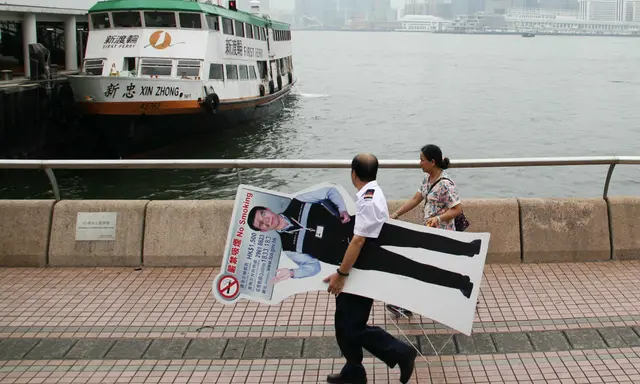Hong Kong remained on high alert for flooding in low-lying areas on Tuesday morning as Typhoon Nida moved away from the city and scuttled through southern China.
But the Hong Kong Observatory said it would downgrade the No 8 typhoon signal to No 3 before 1pm.
Nida, the first major typhoon to shut down the city this year, showed signs of weakening as it headed inland after making landfall near the Dapeng Peninsula in Guangdong province at 4am.
Overnight many areas of Hong Kong, battered by strong gales, reported as much as 60mm of rain as the eye of the storm passed within 40km of the city.
What you need to know:
● Nida has weakened into a severe tropical storm and is moving gradually to the inland areas of Guangdong, further away from Hong Kong.
●The Gale or Storm Signal No 8 is expected to remain in effect this morning, but the Observatory will downgrade it to No 3 before 1pm.
●Classes at all schools are suspended all day.
● Rail and MTR bus services have been adjusted, with most lines running at 10–15 minute intervals.
● Ferries to and between outlying islands are suspended.
● Trams on Hong Kong Island are suspended.
● Kowloon Motor Bus company, Firstbus and Citybus have all suspended daytime services.
● An extremely limited number of flights are arriving at Hong Kong Airport.
● Taxi services are sporadic, with drivers dictating cash tips for service.
A southwesterly No 8 storm signal, issued since 8.40pm on Monday, remained in force, leading to authorities enforcing a range of precautions:
• All primary, secondary and special needs schools would be closed on Tuesday, the Education Bureau announced.
• Trading at the Hong Kong stock and futures market was delayed, affecting the securities market, including Shanghai-Hong Kong Stock Connect trading, and the derivatives market. Markets would resume trading in the afternoon if the storm signal was downgraded before midday, otherwise all sessions would be suspended for the day.
• All hearings at the city’s courts and tribunals were adjourned all day.
The Airport Authority said about 325 flights to and from Hong Kong between 6am and 9pm were expected to be rescheduled on Tuesday, on top of the 156 cancelled ahead of the typhoon’s arrival on Monday. Singapore Airlines flight 1 from San Francisco to Hong Kong was expected to be the first aircraft to land, but the pilot aborted one landing attempt due to tricky wind conditions at the airport and diverted to Taipei.
Cathay Pacific Airways cancelled all flights in and out of the city until 2pm on Tuesday, and said several flights after that would also be affected.
As of 9am on Tuesday, the authorities were aware of 114 trees knocked down across the city, including in Tuen Mun, Sai Kung and Kowloon Tong.
And 218 Hongkongers sought refuge from the wind and rain at government-run shelters.
No injuries, flooding, landslides or power cuts had been reported. But people were urged to report any floods to the Drainage Services Department on 2300 1110.
While high winds persisted, the threat turned to flooding in low-lying areas. Sea levels in parts of the coast were 0.5 metres above normal.
The combination of southwesterly gales pushing water up from the South China Sea into coastal areas of Hong Kong and high tide shortly after 8.30am on Tuesday raised flood warnings. And heavy rain prompted the Hong Kong Observatory to issue an amber rainstorm warning at 5.20am after more than 60mm fell in many parts of the city, but that was cancelled at 10.45am.
Sandy Song Man-kuen, senior scientific officer at the Observatory, said: “I think all regions may have a risk of flooding due to the heavy rain, not just the high tide and storm surge.”
“If an area is prone to high tide, is a low-lying area, it could be at risk, which is why we remind the public in these areas to take precautions,” she added.
Hong Kong-based storm chaser James Reynolds described Nida as the “biggest threat” to the city since Typhoon Vicente in 2012, which triggered the first No 10 storm signal since 1999.
Nida was expected to move west-northwest towards the Pearl River Estuary at 25km/h.
Reynolds, who was observing the storm from the harbourfront in Kennedy Town, said the storm had been tamed somewhat.
“I think the storm lost a lot of energy as it scraped the coast to the east of Hong Kong,” he observed. “The storm was looking pretty strong, and if it passed 50km further south would have hit Hong Kong very hard.”
Young Kennedy Town resident Daniel Lock went with his family to watch the typhoon on Tuesday morning. Daniel’s father, Lock Wai-keung, said he felt “a little bit disappointed”, as Nida was not as severe as previous typhoons.
“We wanted to catch the wave as it said that it’s going to hit signal No 10,” he said. “But it has not and we are kind of disappointed.”
(SOUTH CHINA MORNING POST)
 简体中文
简体中文





